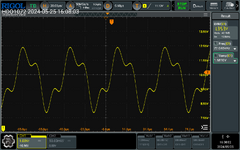Saltwater
Member level 4

Hi,
I'm trying various methods to build a common emitter class A amplifier for home studio use. And I noticed the IRLZ Hexfets im using have a decent amount of harmonic distortion say about 1-3% on the first harmonic. I'm using about 20V supply voltage and running the fets at about a 4v output.
This is on one transistor. "Keeping it in the common emitter spirit" Would it make sense? To have paralel mosfets to keep a lower resistance, and higher output power for the same pre- amplifier gain. Or is this a paradox and will the results actually be worse?

I'm trying various methods to build a common emitter class A amplifier for home studio use. And I noticed the IRLZ Hexfets im using have a decent amount of harmonic distortion say about 1-3% on the first harmonic. I'm using about 20V supply voltage and running the fets at about a 4v output.
This is on one transistor. "Keeping it in the common emitter spirit" Would it make sense? To have paralel mosfets to keep a lower resistance, and higher output power for the same pre- amplifier gain. Or is this a paradox and will the results actually be worse?









